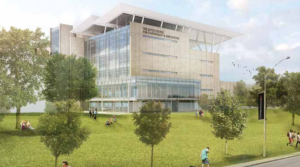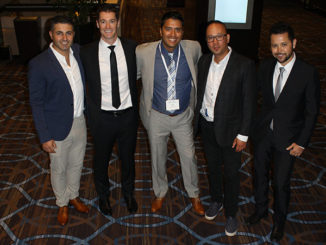
The CaGBC has released a Zero Carbon Buildings Framework that will become the standard for zero carbon buildings in Canada, and Mohawk College’s The Joyce Centre for Partnership & Innovation will be one of ten pilots that will help determine the requirements for this Standard. True to its commitment to shrink its carbon footprint, Mohawk College has already constructed two LEED Gold certified buildings.
The Joyce Centre for Partnership & Innovation is scheduled to be open for students and partners starting in the fall of 2018. The following feature was provided by Mohawk about the project, its intentions, and its approach to creating a net zero carbon building.
To watch live progress of the project, visit Mohawk’s web feed at http://www.mohawknewsdesk.ca/centre-for-partnership–innovation/.
An architectural landmark
Opening in 2018, the Joyce Centre for Partnership & Innovation will comprise 90,000 square feet of state-of-the-art labs, workshops, lecture theatres, industry training centres and showcases under one iconic roof at Mohawk College’s Fennell Campus in Hamilton, Ontario.
More than a bold aesthetic statement, the Centre embodies Mohawk’s vision to be the environmental leader its students, staff and partners expect. Designed to meet the highest “green” standards, the Centre will be a net zero energy building, producing as much or more energy as it consumes.
Summary of planned building systems
• High-performance building envelope to maximize heating, cooling, and natural light
• Green roof with extensive planted areas
• Solar panel array (4,345m2, 500 kW)
• Solar thermal array (50 kW)
• Geothermal wells (24 x 180m deep)
• Variable refrigerant flow heat pumps system
• Storm water harvesting (342,000 L)
• Sensor-controlled LED lighting
• High-efficiency plumbing fixtures
• Energy target of <75 ekWh/m2/annum
A Centre for Work Integrated Learning
With its infrastructure left intentionally exposed, the Joyce Centre for Partnership & Innovation will be a living lab for students, faculty and industry partners. Experiential learning and applied research opportunities for students and visitors will include:
• Exposed structural connections in public areas
• Solar panel array monitoring
• Access to “green” roof terraces
• Graphic user interfaces showcasing building systems
Using live building systems data and new simulation software, students will conduct lab experiments and capstone projects to evaluate energy efficiency and areas of opportunity. More critically, our living lab will encourage students to think dynamically and collaborate in emerging, high-demand industry disciplines.



